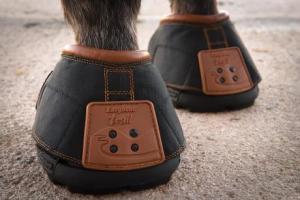In our latest blog we take a look at the key points for taking your horse barefoot with barefoot expert Lucy Nicholas from The Saddlery Shop. Lucy's book The Barefoot Horse- an Introductory Guide to Barefoot and Booting packed full of information about barefoot hoof care can be purchased from The Saddlery Shop. Click here to view!
Here are my key points, if you are considering this method of horsecare-
- I believe there are very few equines that do not have the potential to lead sound, working lives without metal shoes. But ‘transitioning’, post de-shoeing, requires patience. When taking a horse barefoot, you are suddenly allowing the hoof to function at full capacity, with improved circulation and firing of nerves. This will in turn bring to light the true state of health in a newly de-shod hoof. When the shoes are initially removed, a horse with no major issues will usually be sound immediately at pasture, and will often be sound for at least short distances on a hard, flat surface, and only sore on stony surfaces; this horse could transition in just a few weeks. Whereas a horse with very flat soles; one that has been shod with excess ‘flare’ at the hoof wall; or an equine with metabolic challenges may take many more months to get to the same level of comfort. Hoof growth is a reactive process, stimulated by movement and wear, so the hooves need to be given time to respond to the increased requirements placed on them.
- Afraid of excess wear? You can use hoof boots when protection is required; they also provide shock absorption on concussive surfaces.
- With a barefoot horse, you will see precisely how diet affects the feet, notably how quickly high-sugar grass or feeds can be detrimental to hoof health. Diet is key to successfully managing a horse without shoes. High-quality forage and relevant vitamins and minerals, such as those found in very high-specification feed balancers or supplements, are vitally important.
- Choosing a good hoof care professional (whether trimmer or farrier) is key. LANTRA (the UK’s Sector Skills Council for land-based and environmental industries) coordinates the National Occupational Standard (NOS) for Equine Barefoot Care. There are a few different trimming associations in the UK, as well as some good, independent trimmers; and many farriers are becoming more experienced in the field of trimming for work and performance. Seek personal recommendation!
The Saddlery Shop offers a wide range of hoof boots from brands including Easycare, Old Mac, Renegade and much more! Visit the website today to find out more or make a hoof boot or barefoot enquiry which will be answered by Lucy Nicholas!





